Improvement and Assessment of the Absolute Positioning Accuracy of Chinese High-Resolution SAR Satellites
Abstract
:1. Introduction
2. Methods
2.1. Orbit Accuracy
2.2. Atmospheric Path Delay
2.3. Geometric Calibration for a Continuously Moving Configuration
- Obtain and for ground target in the Earth Centered Rotating (ECR) system according to its , , and .
- Set the initial value of the azimuth imaging time .
- Using orbit data, the satellite’s position vector and velocity vector are calculated for the corresponding azimuth imaging time using an interpolation algorithm.
- By substituting , , , and into the Doppler equation of the RD model (Equation (1)), the Doppler centroid frequency value is calculated. Simultaneously, the Doppler centroid frequency value can also be calculated. The change in the azimuth time can then be calculated using the following formula:where represents the rate of change of the Doppler centroid frequency.
- Update the azimuth imaging time .
- If < 0.00001, calculate and , then stop the iteration, export the result , and go to step 7. Otherwise, return to step 3.
- Calculate the slant-range using and for the corresponding azimuth imaging time .
2.4. Multiple-Image Combined Calibration Strategy
3. Experimental Results
3.1. Multiple-Image Combined Calibration Strategy
- Songshan test field: six CRs were used as ICPs.
- Taiyuan and Tianjin test fields: the 1:5000-scale digital orthophoto map (DOM) and Digital Elevation Model (DEM) of the Taiyuan region and the 1:2000-scale DOM and DEM of the Tianjin region were used as control data to obtain ICPs. Their planimetric accuracies and height accuracies are both <1m. Natural targets, such as road intersections, water bodies, or field boundaries, were used throughout to serve as ICPs. The latitudes and longitudes of checkpoints were obtained from the DOM, and their elevations were obtained from the DEM.
- Anping and Xianning test fields: the Xianning and Anping test fields contain a large number of GPS control points with plane and elevation accuracies of 0.3 m and 0.1 m, respectively.
3.2. Comparison of our Geometric Calibration Method and the Conventional Calibration Method
3.3. Assessment of the Absolute Positioning Accuracy for YaoGan-13 and GaoFen-3
4. Discussion
4.1. Geometric Calibration Parameters
4.2. Accuracy Loss Analysis
5. Conclusions
- The internal electronic delay of the instrument is the main error source for the absolute positioning of spaceborne SAR. Use of the methods proposed here can improve absolute positioning accuracy significantly.
- For high resolution spaceborne SAR, the effects of the atmospheric path delay and the “start-stop” approximation on the geometric calibration accuracy should be considered.
- Without using GCPs, a high geolocation accuracy can be ensured for YaoGan-13 and GaoFen-3. In terms of absolute positioning accuracy, domestic SAR satellites are comparable to typical international SAR satellites, such as TerraSAR-X and Sentinel-1A/1B.
Author Contributions
Funding
Conflicts of Interest
References
- Deng, M.; Zhang, G.; Zhao, R.; Zhang, Q.; Li, D.; Li, J. Assessment of the geolocation accuracy of YG-13A high-resolution SAR data. Remote Sens. Lett. 2018, 9, 101–110. [Google Scholar] [CrossRef]
- Deng, M.; Zhang, G.; Zhao, R.; Li, S.; Li, J. Improvement of Gaofen-3 Absolute Positioning Accuracy Based on Cross-Calibration. Sensors 2017, 17, 2903. [Google Scholar] [CrossRef] [PubMed]
- Schubert, A.; Miranda, N.; Geudtner, D.; Small, D. Sentinel-1A/B Combined Product Geolocation Accuracy. Remote Sens. 2017, 9, 607. [Google Scholar] [CrossRef]
- Raggam, H.; Gutjahr, K.; Perko, R.; Schardt, M. Assessment of the Stereo-Radargrammetric Mapping Potential of TerraSAR-X Multibeam Spotlight Data. IEEE Trans. Geosci. Remote Sens. 2010, 48, 971–977. [Google Scholar] [CrossRef]
- Liu, X.; Ma, H.; Sun, W. Study on the Geolocation Algorithm of Space-Borne SAR Image. In Advances in Machine Vision, Image Processing, and Pattern Analysis; Zheng, N., Jiang, X., Lan, X., Eds.; Lecture Notes in Computer Science; Springer: Berlin/Heidelberg, Germany, 2006; Volume 4153. [Google Scholar]
- Zhao, R.; Jiang, Y.; Zhang, G.; Deng, M.; Yang, F. Geometric Accuracy Evaluation of YG-18 Satellite Imagery Based on RFM. Photogramm. Rec. 2017, 32, 33–47. [Google Scholar] [CrossRef] [Green Version]
- Hua, J.; Zhang, G. Research on the methods of inner calibration of spaceborne SAR. In Proceedings of the 2011 IEEE International Geoscience and Remote Sensing Symposium (IGARSS), Vancouver, BC, Canada, 24–29 July 2011; pp. 914–916. [Google Scholar]
- Mohr, J.J.; Madsen, S.N. Geometric calibration of ERS satellite SAR images. IEEE Trans. Geosci. Remote Sens. 2001, 39, 842–850. [Google Scholar] [CrossRef]
- Small, D.; Rosich, B.; Meier, E.; Nüesch, D. Geometric calibration and validation of ASAR imagery. In Proceedings of the CEOS SAR Workshop 2004, Ulm, Germany, 27–28 May 2004. [Google Scholar]
- Cote, S.; Srivastava, S.; Muir, S.; Hawkins, R.; Lukowski, T. RADARSAT-1 AND-2 government calibration activities. In Proceedings of the 2009 IEEE International Geoscience and Remote Sensing Symposium (IGARSS), Cape Town, South Africa, 12–17 July 2009; p. II-890. [Google Scholar]
- Shimada, M.; Isoguchi, O.; Tadono, T.; Isono, K. PALSAR Radiometric and Geometric Calibration. IEEE Trans. Geosci. Remote Sens. 2009, 47, 3915–3932. [Google Scholar] [CrossRef]
- Nitti, D.O.; Nutricato, R.; Lorusso, R.; Lombardi, N.; Bovenga, F.; Bruno, M.F.; Chiaradia, M.T.; Milillo, G. On the geolocation accuracy of COSMO-SkyMed products. In Proceedings of the SAR Image Analysis, Modeling, and Techniques XV; SPIE: Bellingham, WA, USA, 2015; Volume 9642, p. 96420D. [Google Scholar]
- Schwerdt, M.; Brautigam, B.; Bachmann, M.; Doring, B.; Schrank, D.; Gonzalez, J.H. Final TerraSAR-X Calibration Results Based on Novel Efficient Methods. IEEE Trans. Geosci. Remote Sens. 2010, 48, 677–689. [Google Scholar] [CrossRef]
- Schwerdt, M.; Schrank, D.; Bachmann, M.; Gonzalez, J.H.; Döring, B.J.; Tous-Ramon, N.; Antony, J.W. Calibration of the TerraSAR-X and the TanDEM-X satellite for the TerraSAR-X mission. In Proceedings of the 9th European Conference on Synthetic Aperture Radar; VDE: Frankfurt, Germany, 2012; pp. 56–59. [Google Scholar]
- Schwerdt, M.; Schmidt, K.; Ramon, N.T.; Alfonzo, G.C.; Döring, B.J.; Zink, M.; Prats-Iraola, P. Independent verification of the Sentinel-1A system calibration. Geosci. Remote Sens. Symp. 2014, 9, 994–1007. [Google Scholar]
- Schwerdt, M.; Schmidt, K.; Tous Ramon, N.; Klenk, P.; Yague-Martinez, N.; Prats-Iraola, P.; Zink, M.; Geudtner, D. Independent System Calibration of Sentinel-1B. Remote Sens. 2017, 9, 511. [Google Scholar] [CrossRef]
- Guo, X.; Zhang, Q.; Zhao, Q.; Guo, J. Precise orbit determination for LEO satellites using single-frequency GPS observations. Chin. Space Sci. Technol. 2013, 33, 41–46. [Google Scholar]
- Eineder, M.; Minet, C.; Steigenberger, P.; Cong, X.; Fritz, T. Imaging Geodesy—Toward Centimeter-Level Ranging Accuracy with TerraSAR-X. IEEE Trans. Geosci. Remote Sens. 2011, 49, 661–671. [Google Scholar] [CrossRef]
- Ding, C.; Liu, J.; Lei, B.; Qiu, X. Preliminary exploration of systematic geolocation accuracy of GF-3 SAR satellite system. J. Radars 2017, 6, 11–16. [Google Scholar] [CrossRef]
- Schubert, A.; Jehle, M.; Small, D.; Meier, E. Influence of Atmospheric Path Delay on the Absolute Geolocation Accuracy of TerraSAR-X High-Resolution Products. IEEE Trans. Geosci. Remote Sens. 2010, 48, 751–758. [Google Scholar] [CrossRef]
- Jehle, M.; Perler, D.; Small, D.; Schubert, A.; Meier, E. Estimation of Atmospheric Path Delays in TerraSAR-X Data using Models vs. Measurements. Sensors 2008, 8, 8479–8491. [Google Scholar] [CrossRef] [PubMed]
- Li, S.; Zhang, G.; Tang, X.; Huang, W. A method for detecting the atmospheric refraction effect using satellite remote sensing. Remote Sens. Lett. 2016, 7, 985–993. [Google Scholar] [CrossRef]
- Schubert, A.; Small, D.; Miranda, N.; Geudtner, D.; Meier, E. Sentinel-1A Product Geolocation Accuracy: Commissioning Phase Results. Remote Sens. 2015, 7, 9431–9449. [Google Scholar] [CrossRef] [Green Version]
- Deng, M.; Zhang, G.; Zhao, R.; Li, S.; Li, J. Application of the atmospheric delay correction model in YG-13A range calibration. J. Remote Sens. 2018, 22, 373–380. [Google Scholar]
- Wang, T.; Zhang, G.; Li, D.; Zhao, R.; Deng, M.; Zhu, T.; Yu, L. Planar block adjustment and orthorectification of Chinese spaceborne SAR YG-5 imagery based on RPC. Int. J. Remote Sens. 2018, 39, 640–654. [Google Scholar] [CrossRef]
- Merryman Boncori, J.P.; Papoutsis, I.; Pezzo, G.; Tolomei, C.; Atzori, S.; Ganas, A.; Karastathis, V.; Salvi, S.; Kontoes, C.; Antonioli, A. The February 2014 Cephalonia Earthquake (Greece): 3D Deformation Field and Source Modeling from Multiple SAR Techniques. Seismol. Res. Lett. 2015, 86, 124–137. [Google Scholar] [CrossRef]

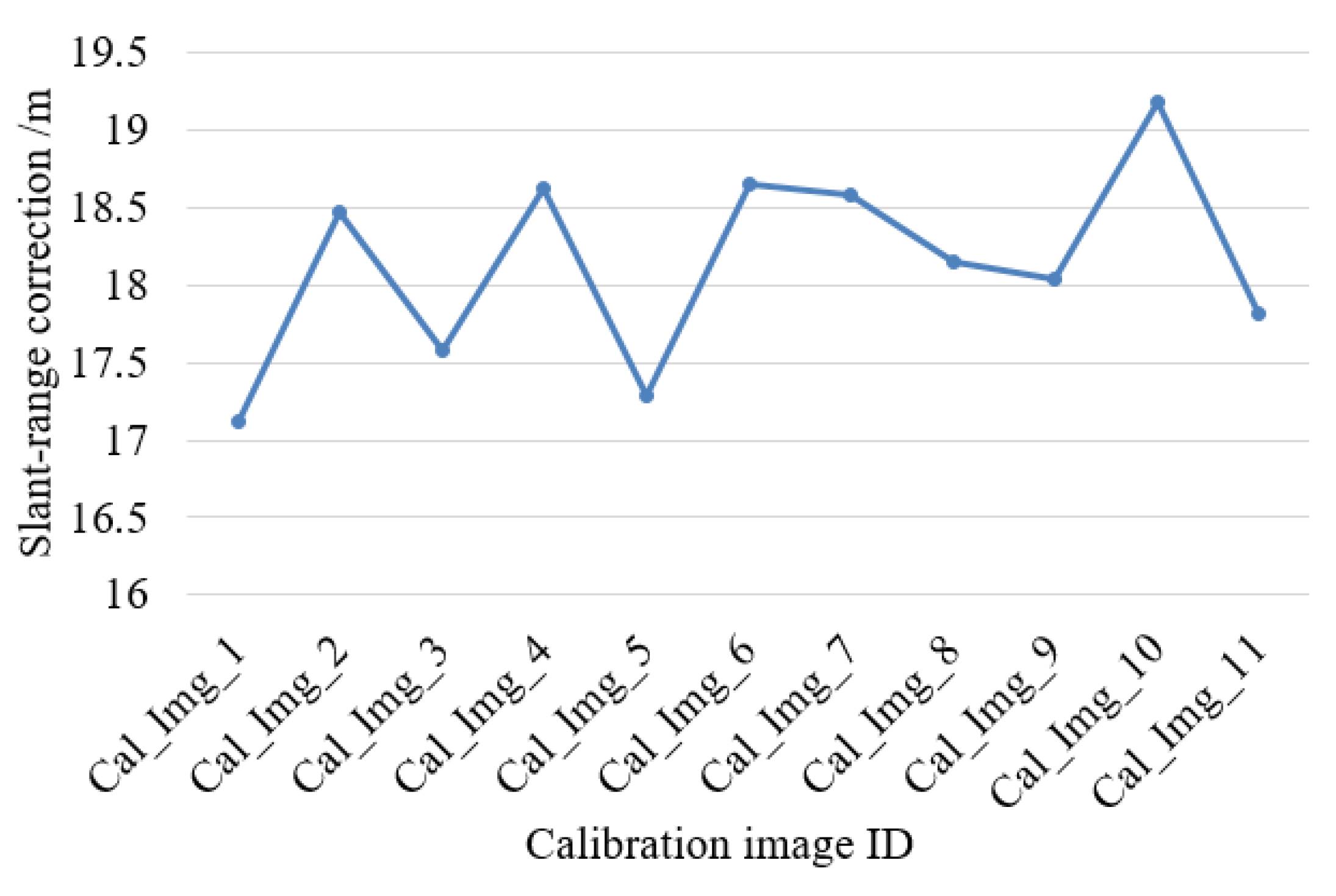

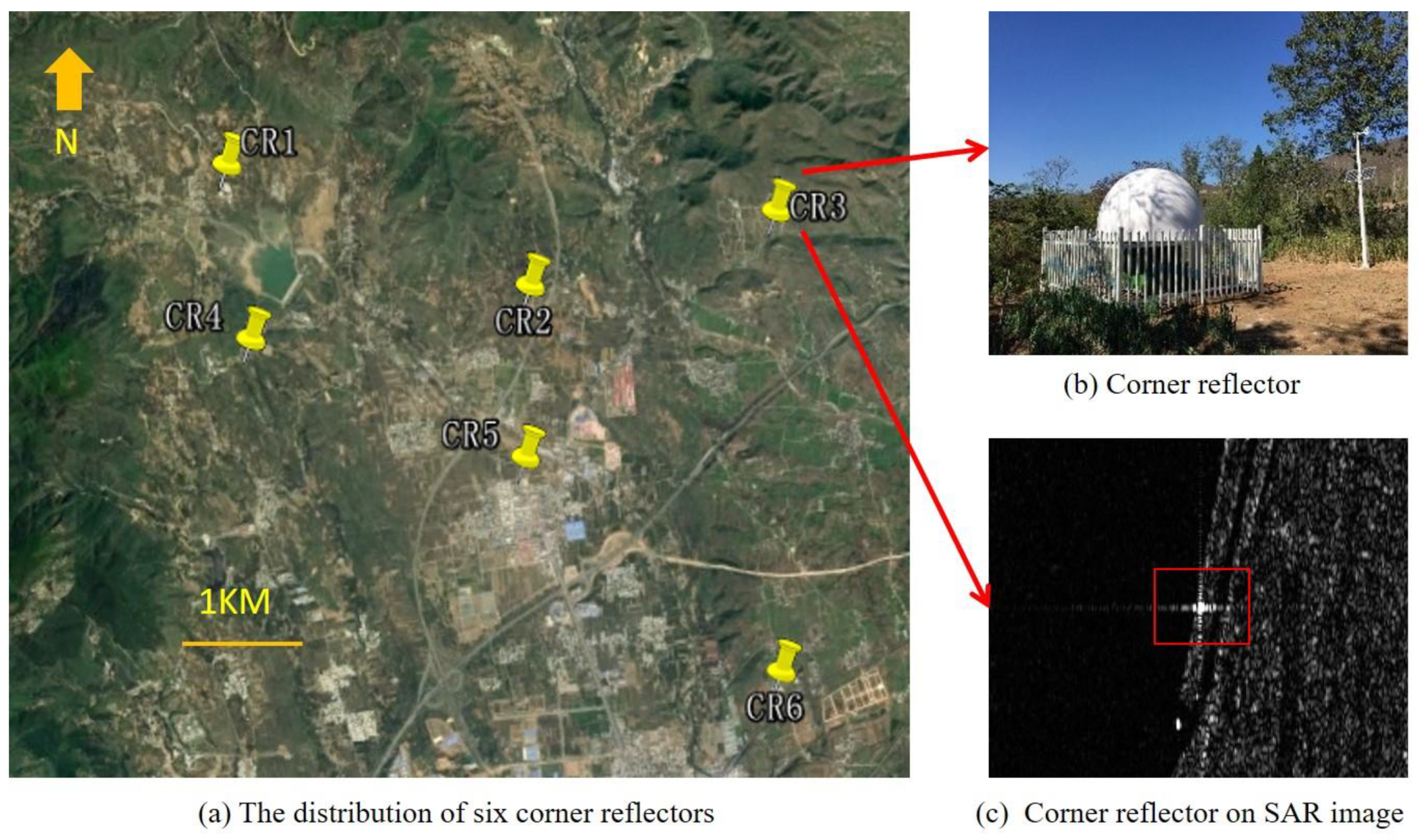
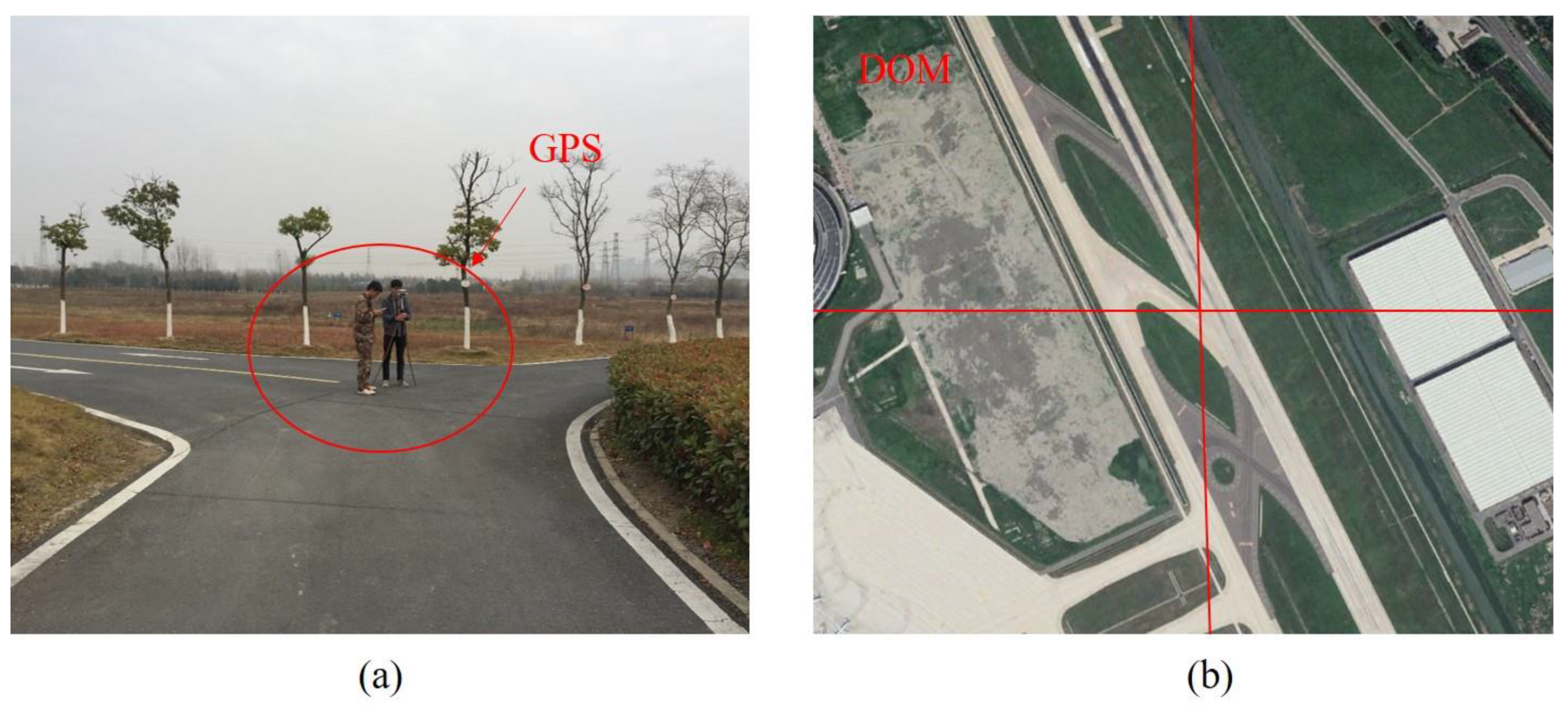
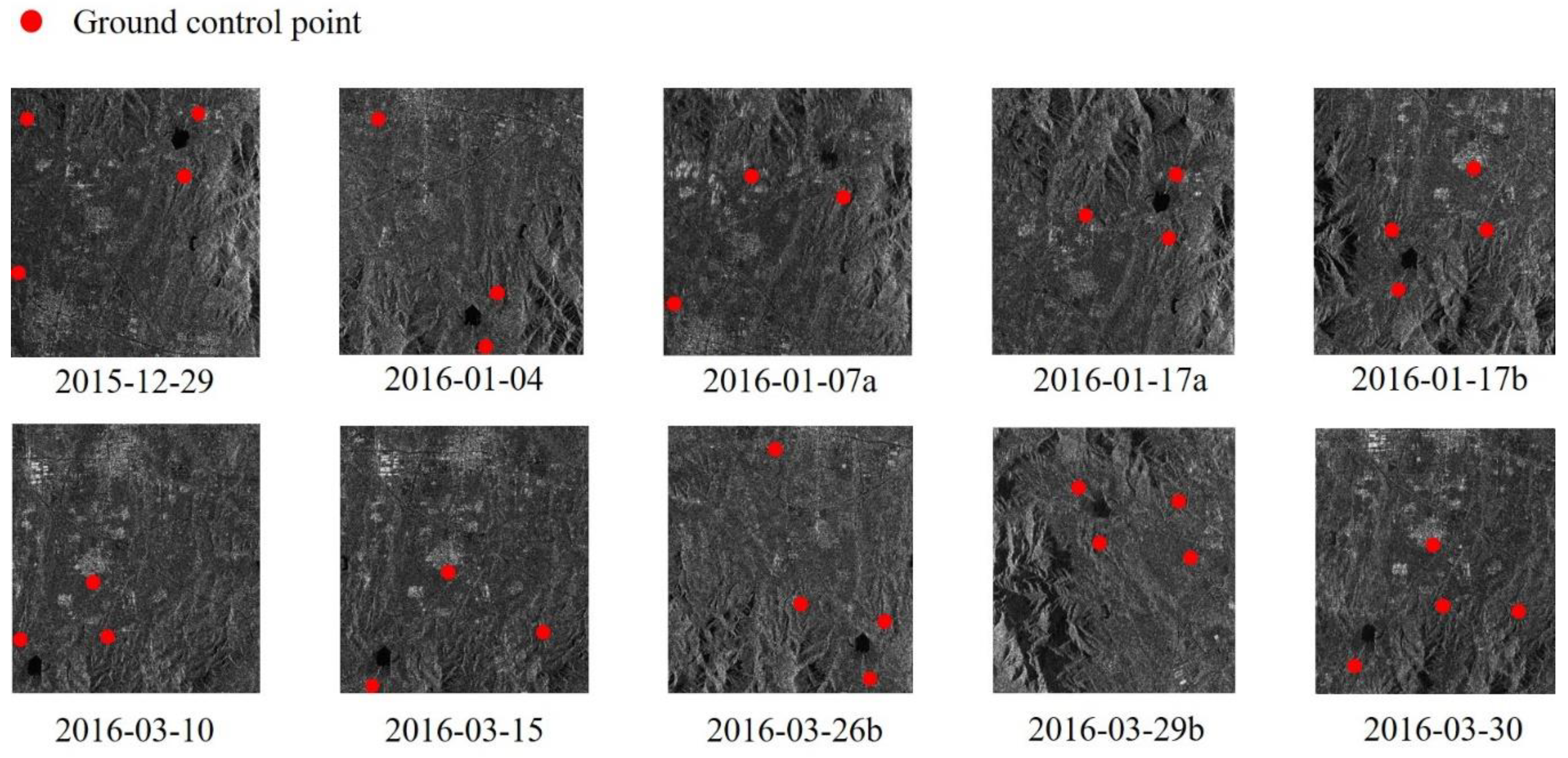


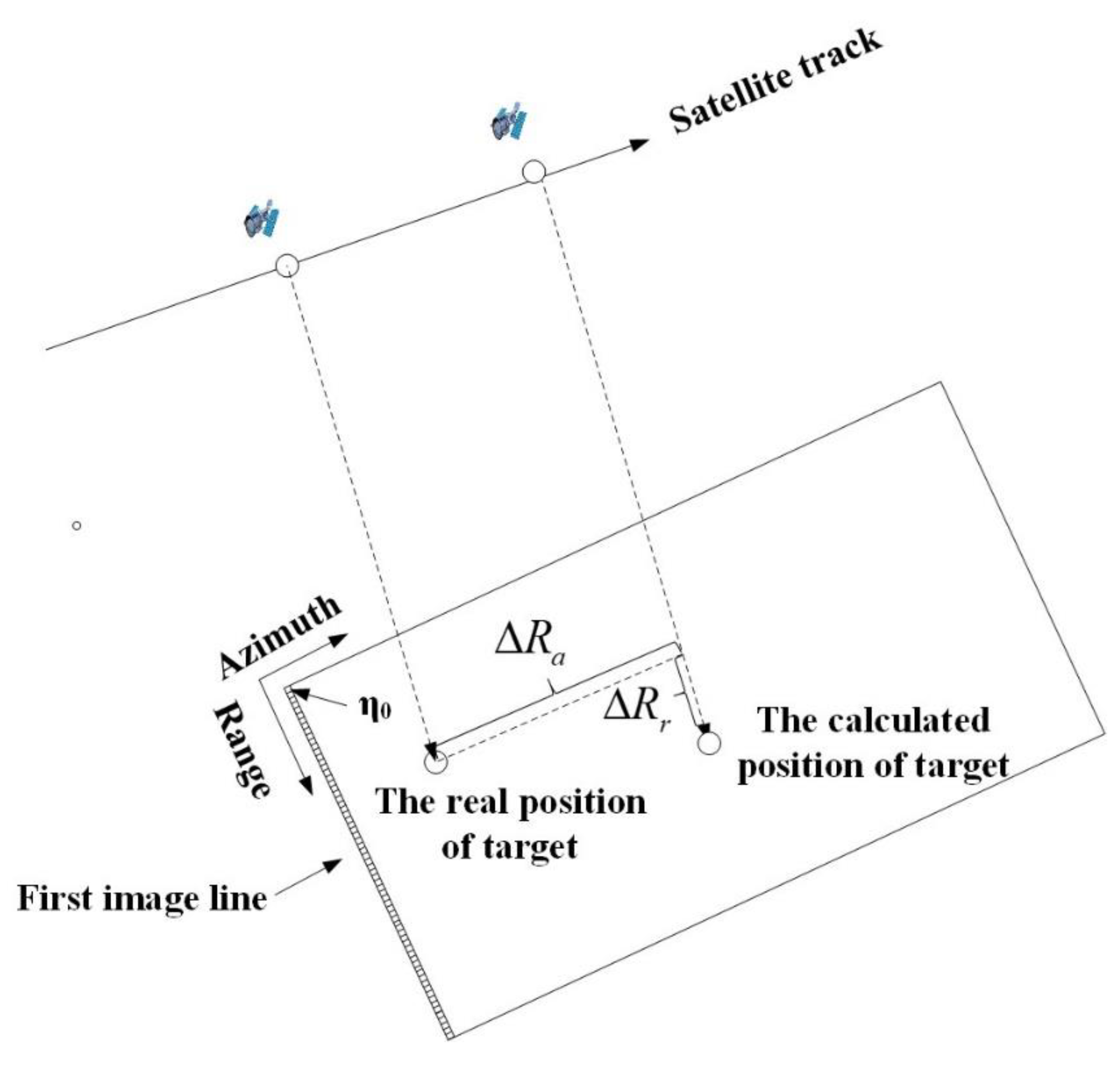
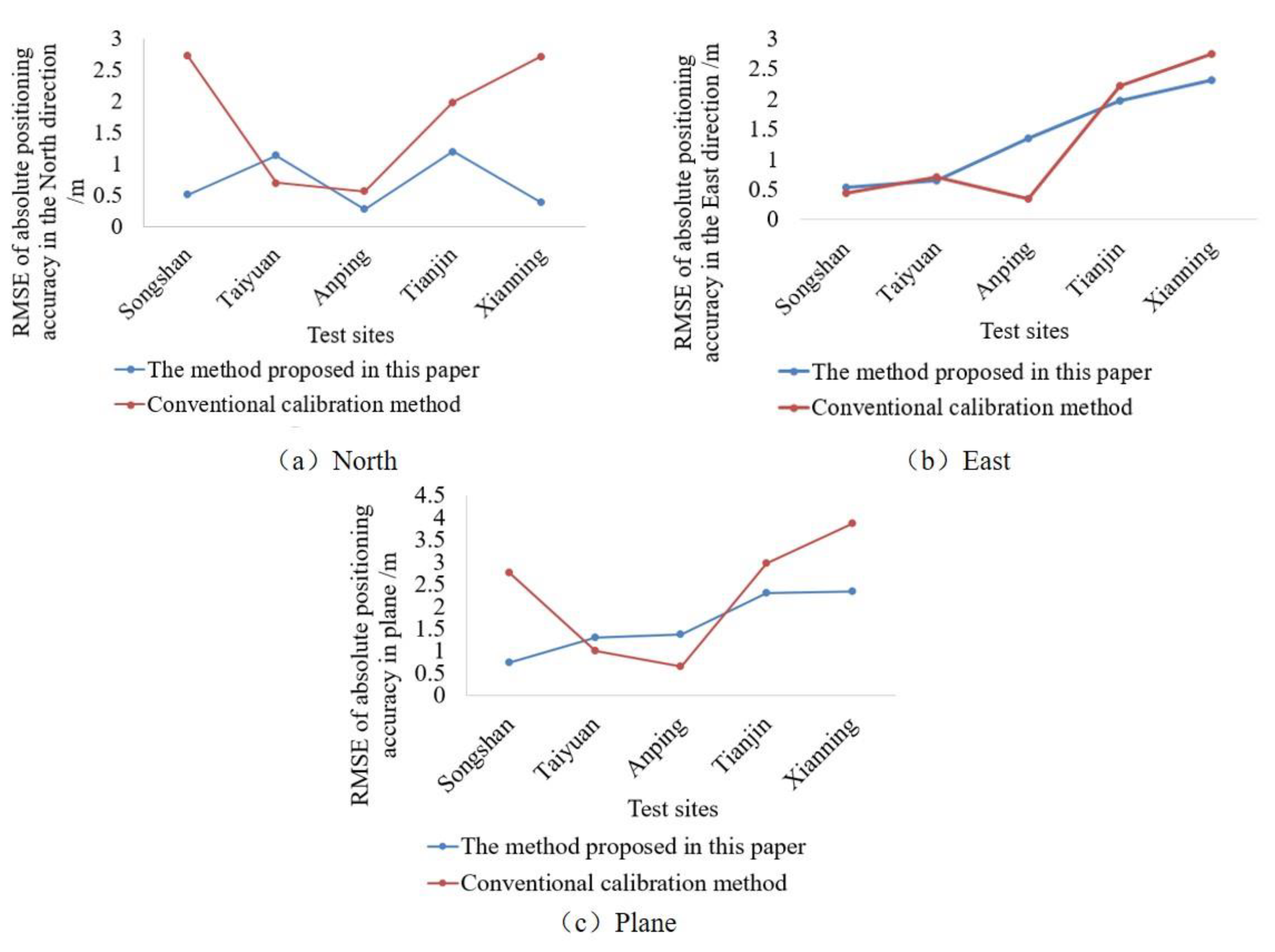
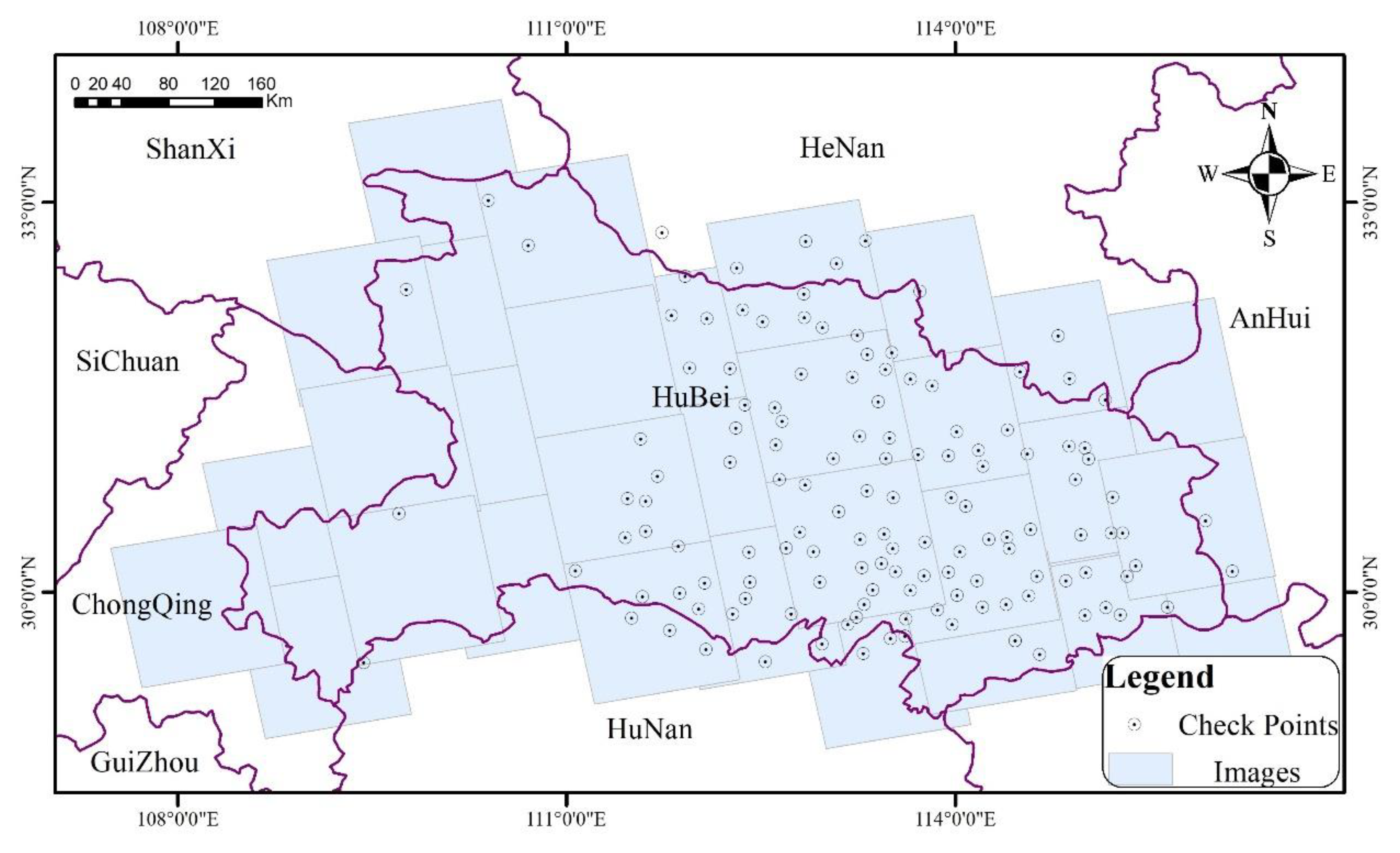
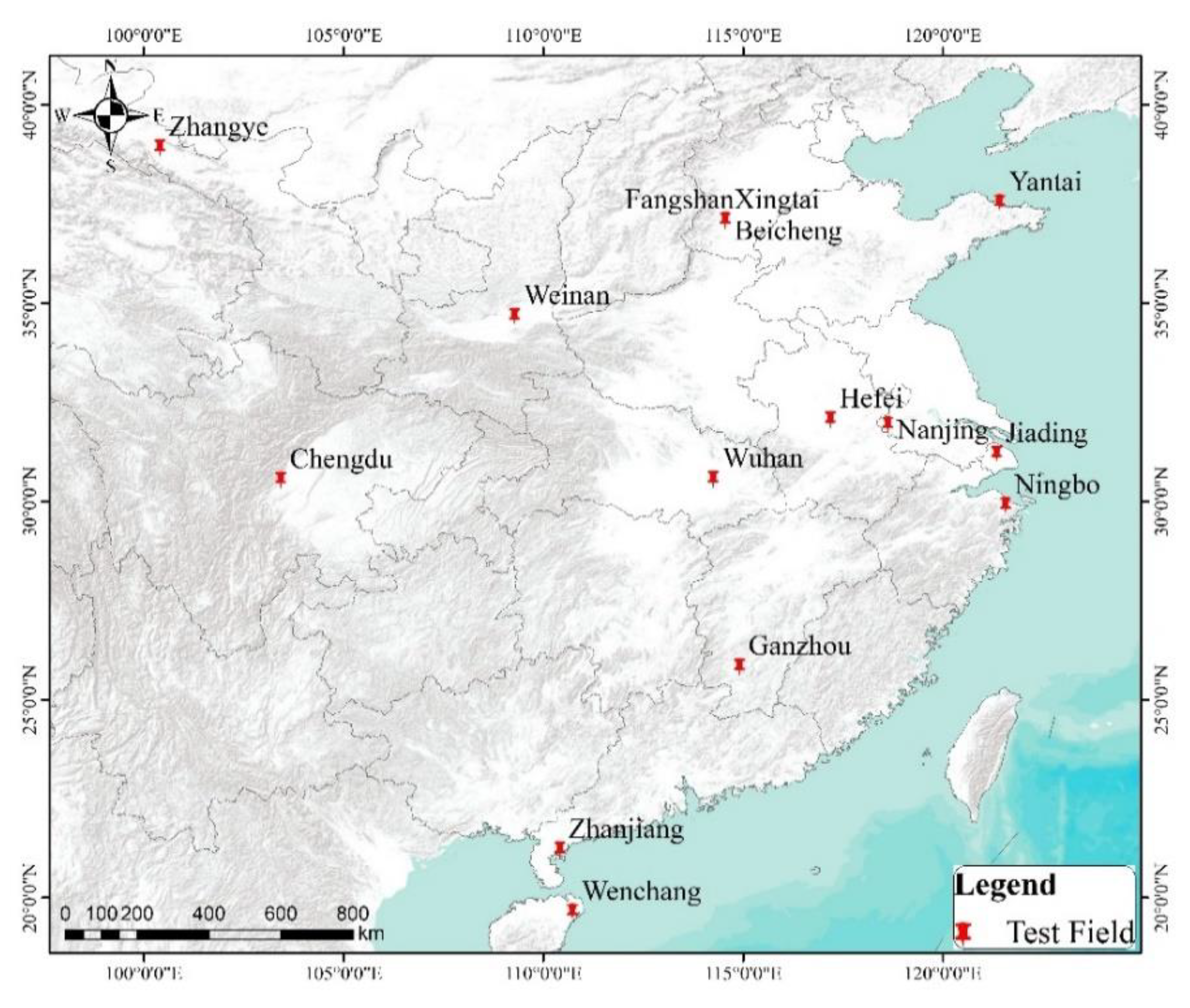
| Satellite | Launch Date | Average Altitude | Max. Resolution | Polarization | Band |
|---|---|---|---|---|---|
| YaoGan-13 | December 2015 | 500 km | 0.5 m | Single | X |
| GaoFen-3 | August 2016 | 755 km | 1 m | Full | C |
| Satellite | Area | Launch Date | Absolute Positioning Accuracy (m) |
|---|---|---|---|
| ERS-1/2 | European | 1991/1995 | <10/<10 |
| ENVISAT-ASAR | European | 2002 | <2 |
| RADARSAT-1/2 | Canada | 1995/2007 | <40/17 |
| ALOS-1/2 | Japan | 2006/2014 | 9.7/- |
| Cosmo-Skymed | Italy | 2007/2008/2010 | <3 |
| TerraSAR-X | Germany | 2007 | <1 |
| TanDEM-X | Germany | 2010 | <1 |
| Sentinal-1A/1B | European | 2014/2016 | <3/<3 |
| Satellite | Imaging Mode | Test Field | Imaging Date | Incidence Angle (°) | Orbit | Look Side |
|---|---|---|---|---|---|---|
| YaoGan-13 | Stripmap-1 mode (resolution: 1.5 m) | Songshan | 29 December 2015 | 46.1 | Desc | R |
| 04 January 2016 | 46.9 | Asc | L | |||
| 07a January 2016 | 54.6 | Desc | R | |||
| 17a January 2016 | 50.9 | Desc | R | |||
| 17b January 2016 | 48.9 | Asc | R | |||
| 10 March 2016 | 45.5 | Asc | R | |||
| 15 March 2016 | 48.0 | Asc | R | |||
| 26b March 2016 | 50.4 | Asc | L | |||
| 29b March 2016 | 38.0 | Asc | R | |||
| 30 March 2016 | 53.8 | Asc | R |
| Satellite | Imaging Mode | Test Field | Imaging Date | Incidence Angle (°) | Orbit | Look Side |
|---|---|---|---|---|---|---|
| YaoGan-13 | Stripmap-1 mode (resolution: 1.5 m) | Songshan | 02 April 2016 | 45.7 | Desc | L |
| Taiyuan | 01 June 2016 | 48.8 | Desc | R | ||
| Anping | 09 June 2016 | 49.9 | Desc | L | ||
| Tianjin | 10 June 2016 | 45.5 | Desc | R | ||
| Xianning | 12 June 2016 | 46.5 | Asc | L |
| Number of Calibration Images | 1 | 2 | 3 | 4 | 5 | 6 | 7 | 8 | 9 |
|---|---|---|---|---|---|---|---|---|---|
| Number of image permutations | 10 | 45 | 120 | 210 | 252 | 210 | 120 | 45 | 10 |
| Number of Calibration Images | 1 | 2 | 3 | 4 | 5 | 6 | 7 | 8 | 9 |
|---|---|---|---|---|---|---|---|---|---|
| Standard deviation of slant-range correction (m) | 0.670 | 0.464 | 0.359 | 0.289 | 0.237 | 0.193 | 0.155 | 0.119 | 0.079 |
| Standard deviation of systematic azimuth shifts (ms) | 0.079 | 0.057 | 0.044 | 0.035 | 0.029 | 0.024 | 0.019 | 0.014 | 0.009 |
| Method | Direction | Item | Value |
|---|---|---|---|
| Conventional calibration method | Range | Slant-range correction | +13.030 m |
| Azimuth | Systematic azimuth shift | −0.00373 s | |
| The method proposed in this paper | Range | Slant-range correction | +17.371 m |
| Azimuth | Systematic azimuth shift | −0.000111 s |
| Satellite | Imaging Mode (Resolution) | Test Field | Imaging Date | Calibration | Absolute Positioning Accuracy (m) | ||
|---|---|---|---|---|---|---|---|
| North | East | Plane | |||||
| YaoGan-13 | Stripmap-1 (1.5 m) | Songshan | 02 April 2016 | Before | 4.79 | 21.93 | 22.45 |
| After | 0.42 | 0.50 | 0.65 | ||||
| Taiyuan | 01 June 2016 | Before | 4.23 | 20.43 | 20.87 | ||
| After | 0.91 | 0.63 | 1.11 | ||||
| Anping | 09 June 2016 | Before | 6.46 | 20.99 | 21.96 | ||
| After | 0.46 | 1.25 | 1.33 | ||||
| Tianjin | 10 June 2016 | Before | 4.95 | 23.78 | 24.29 | ||
| After | 1.06 | 1.98 | 2.24 | ||||
| Xianning | 12 June 2016 | Before | 6.28 | 23.25 | 24.08 | ||
| After | 0.32 | 2.33 | 2.35 | ||||
| Stripmap-2 (1.5 m) | Songshan | 29b March 2016 | Before | 4.44 | 25.11 | 25.50 | |
| After | 0.41 | 0.94 | 1.02 | ||||
| Taiyuan | 28 May 2016 | Before | 6.98 | 30.06 | 30.87 | ||
| After | 1.39 | 0.46 | 1.46 | ||||
| Tianjin | 29 May 2016 | Before | 8.69 | 30.45 | 31.66 | ||
| After | 1.09 | 0.86 | 1.39 | ||||
| Slidingspot-1 (1 m) | Xianning | 21 May 2016 | Before | 4.68 | 37.12 | 37.41 | |
| After | 1.85 | 1.78 | 2.57 | ||||
| Tianjin | 22 May 2016 | Before | 5.26 | 31.43 | 31.87 | ||
| After | 1.18 | 1.66 | 2.04 | ||||
| Slidingspot-2 (1 m) | Songshan | 05 January 2016 | Before | 10.82 | 42.50 | 43.86 | |
| After | 0.23 | 0.68 | 0.72 | ||||
| Taiyuan | 21 May 2016 | Before | 7.04 | 35.14 | 35.84 | ||
| After | 0.85 | 1.34 | 1.59 | ||||
| GaoFen-3 | Stripmap-1 (5 m) | Taiyuan | 30 December 2016 | Before | 3.25 | 30.17 | 30.34 |
| After | 1.73 | 3.20 | 3.64 | ||||
| Taiyuan | 11 January 2017 | Before | 3.66 | 27.81 | 28.05 | ||
| After | 2.53 | 2.03 | 3.25 | ||||
| Stripmap-2 (5 m) | Tianjin | 17 February 2017 | Before | 7.25 | 24.92 | 25.96 | |
| After | 1.20 | 4.12 | 4.29 | ||||
| Tianjin | 18 March 2017 | Before | 7.09 | 27.55 | 28.45 | ||
| After | 1.70 | 3.86 | 4.22 | ||||
| Test Area | Satellite | Imaging Mode | Ground Resolution (m) | Number of Checkpoints |
|---|---|---|---|---|
| Hubei province | GaoFen-3 | Stripmap-3 | 10 m | 135 |
| Test Field | GCPs | ICPs | Calibration | Maximum Residual (m) | RMSE (m) | ||||
|---|---|---|---|---|---|---|---|---|---|
| East | North | Plane | East | North | Plane | ||||
| Hubei province | 0 | 135 | Before | 54.80 | 13.74 | 55.01 | 38.70 | 4.54 | 38.97 |
| After | 14.90 | −17.98 | 19.10 | 4.60 | 7.70 | 8.97 | |||
| Satellite | Imaging Mode (Resolution) | Test Field | ICPs | Intersection Angle(°) | Absolute Positioning Accuracy (m) | |||
|---|---|---|---|---|---|---|---|---|
| North | East | Plane | Height | |||||
| YaoGan-13 | Sliding spot (1 m) | Zhangye | 11 | 63 | 0.90 | 0.83 | 1.22 | 2.56 |
| Chengdu | 19 | 88 | 1.32 | 0.78 | 1.53 | 0.82 | ||
| Weinan | 10 | 80 | 0.96 | 2.01 | 2.22 | 1.85 | ||
| Xingtai | 19 | 64 | 1.18 | 0.92 | 1.49 | 0.92 | ||
| Wuhan | 11 | 77 | 0.92 | 2.94 | 3.08 | 1.04 | ||
| Ganzhou | 11 | 71 | 2.88 | 4.83 | 5.62 | 3.14 | ||
| Zhanjiang | 14 | 76 | 1.03 | 0.44 | 1.12 | 1.62 | ||
| Wenchang | 18 | 80 | 0.64 | 2.68 | 2.75 | 1.07 | ||
| Beichen | 20 | 75 | 1.36 | 2.07 | 2.47 | 2.00 | ||
| Fangshan | 16 | 48 | 1.57 | 0.61 | 1.68 | 0.55 | ||
| Hefei | 14 | 65 | 1.80 | 3.70 | 4.11 | 1.11 | ||
| Nanjing | 15 | 79 | 1.49 | 2.15 | 2.61 | 1.64 | ||
| Yantai | 19 | 68 | 1.46 | 6.83 | 6.98 | 2.06 | ||
| Jiading | 22 | 77 | 1.47 | 2.16 | 2.61 | 2.32 | ||
| Ningbo | 21 | 98 | 2.08 | 0.82 | 2.23 | 5.45 | ||
| RMSE | - | - | 3.21 | 2.22 | ||||
| Satellite | Imaging Mode | Slant-Range Correction (m) | Systematic Azimuth Shift (s) | Geolocation Error (m) | |
|---|---|---|---|---|---|
| Range | Azimuth | ||||
| YaoGan-13 | Stripmap-1 (1.5 m) | +17.371 | −0.000111 | 17.371 | 0.843 |
| Stripmap-2 (1.5 m) | +17.856 | −0.000101 | 17.856 | −0.767 | |
| Slidingspot-1 (1 m) | +20.543 | +0.000067 | 20.543 | 0.509 | |
| Slidingspot-2 (1 m) | +19.834 | +0.000064 | 19.834 | 0.486 | |
| GaoFen-3 | Stripmap-1 (5 m) | −18.838 | +0.000494 | 18.838 | 3.754 |
| Stripmap-2 (5 m) | −20.886 | +0.000212 | 20.886 | 1.611 | |
© 2019 by the authors. Licensee MDPI, Basel, Switzerland. This article is an open access article distributed under the terms and conditions of the Creative Commons Attribution (CC BY) license (http://creativecommons.org/licenses/by/4.0/).
Share and Cite
Deng, M.; Zhang, G.; Cai, C.; Xu, K.; Zhao, R.; Guo, F.; Suo, J. Improvement and Assessment of the Absolute Positioning Accuracy of Chinese High-Resolution SAR Satellites. Remote Sens. 2019, 11, 1465. https://doi.org/10.3390/rs11121465
Deng M, Zhang G, Cai C, Xu K, Zhao R, Guo F, Suo J. Improvement and Assessment of the Absolute Positioning Accuracy of Chinese High-Resolution SAR Satellites. Remote Sensing. 2019; 11(12):1465. https://doi.org/10.3390/rs11121465
Chicago/Turabian StyleDeng, Mingjun, Guo Zhang, Chenglin Cai, Kai Xu, Ruishan Zhao, Fengchen Guo, and Jing Suo. 2019. "Improvement and Assessment of the Absolute Positioning Accuracy of Chinese High-Resolution SAR Satellites" Remote Sensing 11, no. 12: 1465. https://doi.org/10.3390/rs11121465





